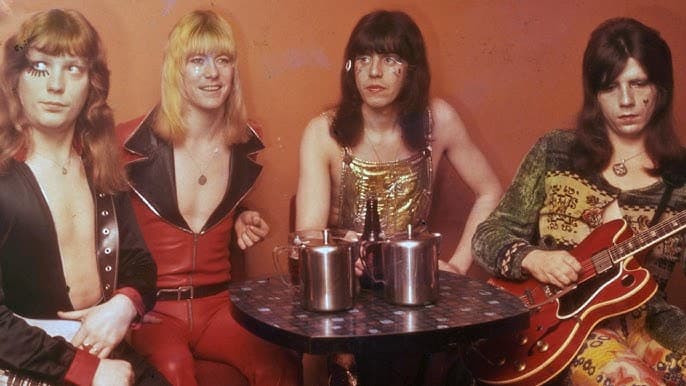
In the vibrant sonic landscape of the mid-1970s, few bands captured the era’s electrifying spirit quite like Sweet. Known for their commanding rock anthems like “Ballroom Blitz” and “Fox on the Run,” the band stunned fans with an audacious move: a high-voltage cover of the Four Tops’ 1966 Motown classic, “Reach Out I’ll Be There.” This was no simple tribute—it was a bold reinvention that transformed the soulful hit into a massive, unforgettable stadium anthem, showcasing Sweet’s fearless musical vision.
This explosive rendition first appeared on the 1974 European release of Desolation Boulevard and later surfaced as the B-side to the band’s smash hit, “The Ballroom Blitz,” in select markets. Although it never climbed high on the charts as an A-side in major markets such as the U.K. or U.S., its placement on a key album and alongside one of their most celebrated singles ensured it would reach a wide audience, becoming a pivotal chapter in the Sweet saga. It demonstrated not only the band’s rock credentials but also a daring willingness to overhaul beloved material and redefine their sound.
The original version of “Reach Out I’ll Be There,” written by the legendary Holland-Dozier-Holland songwriting trio, is a cornerstone of soul music. Driven by Levi Stubbs’ impassioned and anguished vocals, it conveys a desperate promise of loyalty—raw, high-wire emotion set against a nimble Motown groove. Sweet’s cover, by stark contrast, wrenched the song from the lush, intimate confines of Hitsville U.S.A. and thrust it into the roar of the arena. This was more than a respectful nod to a classic—it was a sonic upheaval.
Where Stubbs’ voice teetered on the edge of emotional collapse, frontman Brian Connolly delivers the song’s pledge as a bombastic, glam-rock shout, a confident proclamation belted out from a vast stage. Connolly’s vocals carried a freshness that reimagined the song’s emotional core with a swagger and theatricality unique to Sweet. The choice to record this challenging classic spoke volumes about the band’s self-awareness and ambition. As Connolly once reflected in an interview:
“We wanted to show the world we could take something rooted in soul, and make it ours. It wasn’t about imitation—it was about transformation.” — Brian Connolly, Lead Vocalist of Sweet
The hard rock edge defined Sweet’s interpretation. Andy Scott’s thick, distorted guitars build a dense, aggressive texture, perfectly complementing Mick Tucker’s relentless, pounding drums. This rhythm section morphs the original’s nimble Motown bounce into a stomping, almost metallic march, a sound designed to captivate stadium crowds and shake the foundations of rock venues. Gone is the original’s flute intro; it’s replaced by a crashing wall of sound that hits the listener like a tidal wave.
Music historian Dr. Lindsay Graves provides context to this remarkable transformation:
“Sweet’s cover of ‘Reach Out I’ll Be There’ is a stellar example of how a classic soul song can be reimagined with a hard rock edge without losing emotional impact. This was a band declaring their versatility and rock authenticity at a time when glam and hard rock were evolving rapidly.” — Dr. Lindsay Graves, Music Historian
This seismic shift made the cover memorable, especially for fans who grew up on Sweet’s signature sound. It wasn’t merely a cover; it was a bold rock statement—a moment where the band asserted their identity beyond the bubblegum pop sometimes assigned to them, staking their claim as serious players in the hard rock arena. The track symbolized a bridge between two musical worlds, bringing the soul intensity of Motown into the electrified realm of 1970s rock.
Bandmate and guitarist Andy Scott explained the creative approach behind the track in a retrospective:
“We weren’t thinking about charts or radio plays. We just wanted to hit harder, sound bigger—make sure every riff and beat counted. That song was us saying, ‘Here we are, this is what Sweet can do.’” — Andy Scott, Guitarist of Sweet
Listening to their version today brings back the vibe of an era defined by flare trousers, towering platform boots, and amplifiers cranked to the max. It becomes clear that, under Sweet’s hands, a timeless song was reincarnated for a new generation, bursting with fresh energy and attitude. Mick Tucker’s driving rhythms and Scott’s distorted guitar layers create a soundscape that embodies the decade’s excess and daring creativity.
Joan Taylor, a contemporary fan who witnessed Sweet’s live performances during their peak years, shared her perspective:
“When Sweet played ‘Reach Out I’ll Be There’ live, it was an electrifying moment—something completely unexpected but utterly thrilling. It was the kind of cover that didn’t just pay tribute; it demanded attention and respect.” — Joan Taylor, Sweet Fan and Concert Attendee
Ultimately, Sweet’s rendition of “Reach Out I’ll Be There” stands as a testament to the power of bold reinterpretation. It crystallized the band’s ability to push musical boundaries and challenge fans’ expectations, forever marking the mid-70s as a time when rock and soul collided in spectacular fashion.